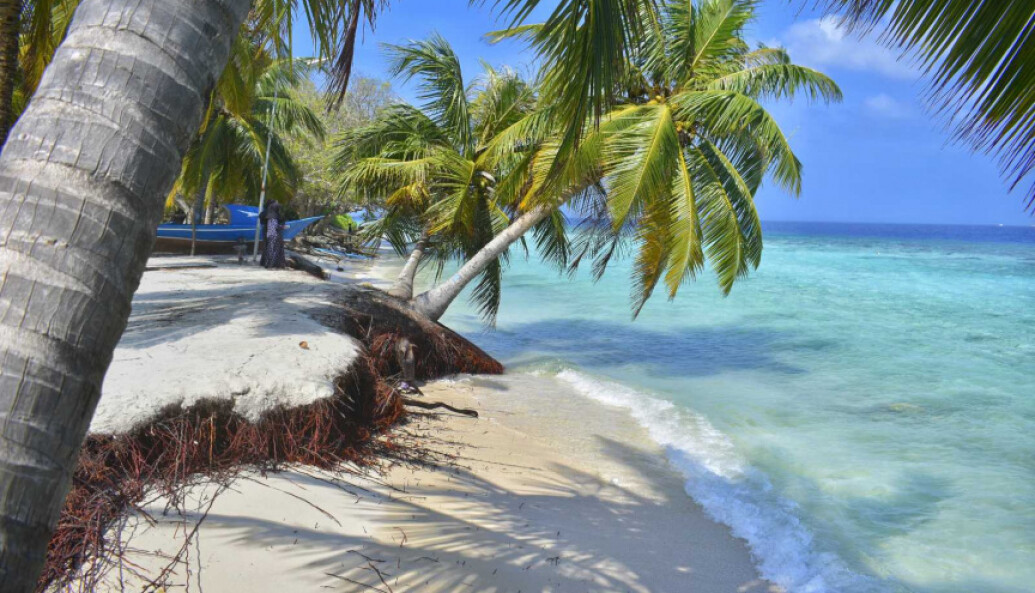What Is Coastal Erosion?
Coastal erosion is the gradual wearing away or loss of land along the shoreline, caused by natural forces such as waves, tides, wind, and currents. In the Maldives, where islands are composed of fragile coral sand and lie barely a meter above sea level, coastal erosion threatens homes, beaches, and critical infrastructure.
Shoreline change is a natural process, but human activities such as poorly planned coastal development, removal of vegetation, and unregulated reclamation can accelerate it. When combined with rising sea levels and stronger wave activity, erosion can lead to permanent loss of land and displacement of communities.

Coastal erosion along a Maldivian shoreline, where retreating sand and exposed tree roots indicate the loss of beach stability due to wave action and rising sea levels. (Source: Maldives Financial Review)
Causes of Coastal Erosion
Coastal erosion and shoreline changes in the Maldives are influenced by both natural and human-induced factors:
Wave and Current Action: Continuous wave motion and longshore currents transport sand and sediments away from beaches.
Sea-Level Rise: Gradual ocean level rise increases the frequency of flooding and amplifies wave impacts.
Storm Surges and Swell Waves: High-energy waves generated by distant or local storms cause rapid erosion and beach loss.
Loss of Coastal Vegetation: Clearing mangroves, beach creepers, and shrubs removes the natural buffer that protects against erosion.
Human Activities: Land reclamation, harbor construction, and poorly designed sea walls alter natural sediment flow and worsen erosion.
Risks and Impacts
Coastal erosion is one of the most pressing environmental hazards for the Maldives, affecting both inhabited islands and resort areas.
Key impacts include:
Land Loss: Permanent reduction of usable land, threatening homes and community facilities.
Infrastructure Damage: Erosion undermines sea walls, jetties, harbors, and roads.
Loss of Vegetation and Biodiversity: Damage to mangroves and coastal shrubs that stabilize shorelines.
Displacement of Communities: Some households face relocation due to severe erosion.
Tourism and Economic Impacts: Loss of beaches affects tourism value and island aesthetics.
The Maldives’ Third National Determined Contribution identifies coastal erosion and vegetation loss as major adaptation concerns requiring nature-based and engineered interventions.
Alert Levels
There is currently no formal national alert system for coastal erosion. However, erosion monitoring is part of national land use and environmental management. The Maldives Meteorological Service (MMS) and Ministry of Tourism and Environment monitor coastal changes and issue public advisories when high tides, storm surges, or swell events increase erosion risks.
Before Erosion Becomes Severe: Get Prepared
• Avoid construction, reclamation, or sand mining near unstable coastlines.
• Preserve and restore coastal vegetation such as mangroves and beach creepers.
• Participate in community replanting programs and support nature-based solutions.
• Engage in local monitoring activities through councils or community groups.
• Incorporate erosion risks into island development and land-use plans.
During an Erosion or Flooding Event: Stay Safe
• Stay away from collapsing or undercut shorelines.
• Avoid using eroded jetties or coastal roads.
• Move vehicles and belongings to safer, higher ground.
• Follow guidance issued by local councils and NDMA during high tide or swell warnings.
After an Erosion Event: Recover and Restore
• Replant native vegetation along affected areas to stabilize soil.
• Support community efforts to restore natural buffers like mangroves.
• Report severe erosion to local authorities and participate in monitoring programs.
• Promote green zoning policies to prevent future damage.
Stay Prepared, Protect Our Shores
Every meter of shoreline matters in the Maldives. Protecting vegetation, respecting natural buffers, and planning responsibly are vital steps toward keeping our islands safe from the advancing sea.